remove seats SKODA SUPERB 2013 2.G / (B6/3T) Owner's Manual
[x] Cancel search | Manufacturer: SKODA, Model Year: 2013, Model line: SUPERB, Model: SKODA SUPERB 2013 2.G / (B6/3T)Pages: 274, PDF Size: 17.31 MB
Page 47 of 274
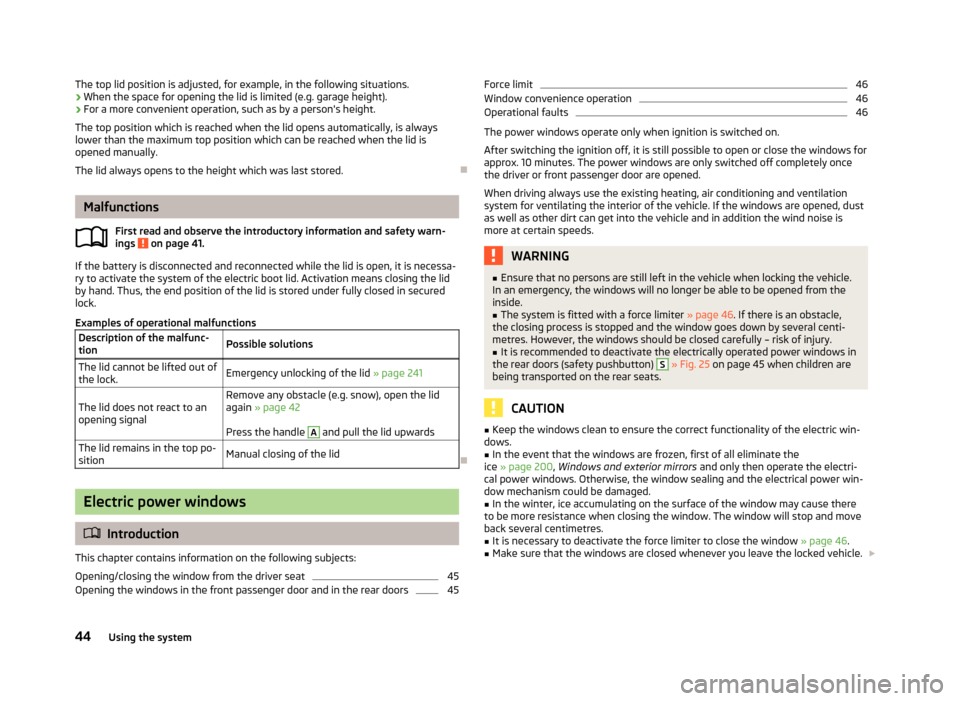
The top lid position is adjusted, for example, in the following situations.
› When the space for opening the lid is limited (e.g. garage height).
› For a more convenient operation, such as by a person's height.
The top position which is reached when the lid opens automatically, is always
lower than the maximum top position which can be reached when the lid is
opened manually.
The lid always opens to the height which was last stored.
Malfunctions
First read and observe the introductory information and safety warn-
ings
on page 41.
If the battery is disconnected and reconnected while the lid is open, it is necessa-
ry to activate the system of the electric boot lid. Activation means closing the lid
by hand. Thus, the end position of the lid is stored under fully closed in secured lock.
Examples of operational malfunctions
Description of the malfunc-
tionPossible solutionsThe lid cannot be lifted out of
the lock.Emergency unlocking of the lid » page 241The lid does not react to an
opening signalRemove any obstacle (e.g. snow), open the lid
again » page 42
Press the handle A
and pull the lid upwards
The lid remains in the top po-
sitionManual closing of the lid
Electric power windows
Introduction
This chapter contains information on the following subjects:
Opening/closing the window from the driver seat
45
Opening the windows in the front passenger door and in the rear doors
45Force limit46Window convenience operation46
Operational faults
46
The power windows operate only when ignition is switched on.
After switching the ignition off, it is still possible to open or close the windows for
approx. 10 minutes. The power windows are only switched off completely once
the driver or front passenger door are opened.
When driving always use the existing heating, air conditioning and ventilation
system for ventilating the interior of the vehicle. If the windows are opened, dust
as well as other dirt can get into the vehicle and in addition the wind noise is
more at certain speeds.
WARNING■ Ensure that no persons are still left in the vehicle when locking the vehicle.
In an emergency, the windows will no longer be able to be opened from the
inside.■
The system is fitted with a force limiter » page 46. If there is an obstacle,
the closing process is stopped and the window goes down by several centi-
metres. However, the windows should be closed carefully – risk of injury.
■
It is recommended to deactivate the electrically operated power windows in
the rear doors (safety pushbutton)
S
» Fig. 25 on page 45 when children are
being transported on the rear seats.
CAUTION
■ Keep the windows clean to ensure the correct functionality of the electric win-
dows.■
In the event that the windows are frozen, first of all eliminate the
ice » page 200 , Windows and exterior mirrors and only then operate the electri-
cal power windows. Otherwise, the window sealing and the electrical power win-
dow mechanism could be damaged.
■
In the winter, ice accumulating on the surface of the window may cause there
to be more resistance when closing the window. The window will stop and move back several centimetres.
■
It is necessary to deactivate the force limiter to close the window » page 46.
■
Make sure that the windows are closed whenever you leave the locked vehicle.
44Using the system
Page 55 of 274
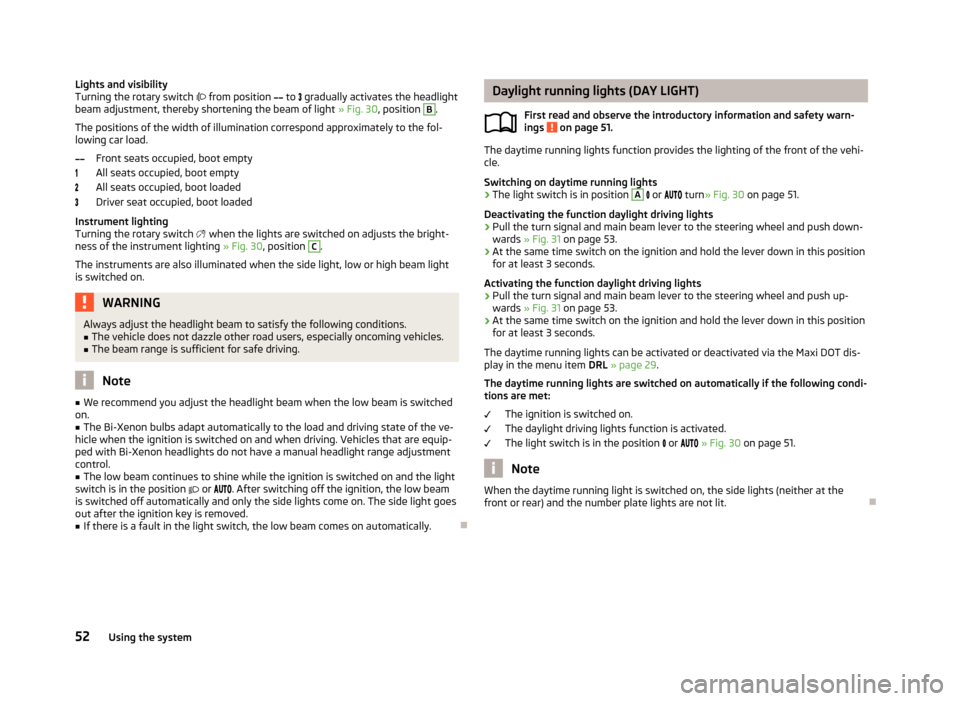
Lights and visibility
Turning the rotary switch from position to gradually activates the headlight
beam adjustment, thereby shortening the beam of light » Fig. 30, position B
.
The positions of the width of illumination correspond approximately to the fol-
lowing car load.
Front seats occupied, boot empty
All seats occupied, boot empty
All seats occupied, boot loaded
Driver seat occupied, boot loaded
Instrument lighting
Turning the rotary switch
when the lights are switched on adjusts the bright-
ness of the instrument lighting » Fig. 30, position
C
.
The instruments are also illuminated when the side light, low or high beam light is switched on.
WARNINGAlways adjust the headlight beam to satisfy the following conditions.■The vehicle does not dazzle other road users, especially oncoming vehicles.■
The beam range is sufficient for safe driving.
Note
■ We recommend you adjust the headlight beam when the low beam is switched
on.■
The Bi-Xenon bulbs adapt automatically to the load and driving state of the ve-
hicle when the ignition is switched on and when driving. Vehicles that are equip- ped with Bi-Xenon headlights do not have a manual headlight range adjustment
control.
■
The low beam continues to shine while the ignition is switched on and the light
switch is in the position or . After switching off the ignition, the low beam
is switched off automatically and only the side lights come on. The side light goes
out after the ignition key is removed.
■
If there is a fault in the light switch, the low beam comes on automatically.
Daylight running lights (DAY LIGHT)
First read and observe the introductory information and safety warn-
ings
on page 51.
The daytime running lights function provides the lighting of the front of the vehi-
cle.
Switching on daytime running lights
›
The light switch is in position
A
or turn » Fig. 30 on page 51.
Deactivating the function daylight driving lights
›
Pull the turn signal and main beam lever to the steering wheel and push down-
wards » Fig. 31 on page 53.
›
At the same time switch on the ignition and hold the lever down in this position
for at least 3 seconds.
Activating the function daylight driving lights
›
Pull the turn signal and main beam lever to the steering wheel and push up- wards » Fig. 31 on page 53.
›
At the same time switch on the ignition and hold the lever down in this position
for at least 3 seconds.
The daytime running lights can be activated or deactivated via the Maxi DOT dis-
play in the menu item DRL » page 29 .
The daytime running lights are switched on automatically if the following condi- tions are met:
The ignition is switched on.
The daylight driving lights function is activated.
The light switch is in the position
or
» Fig. 30 on page 51.
Note
When the daytime running light is switched on, the side lights (neither at the
front or rear) and the number plate lights are not lit.
52Using the system
Page 69 of 274

Seats and useful equipment
Adjusting the seats
Introduction
This chapter contains information on the following subjects:
Manually adjusting the front seats
67
Electric front seat adjustment
67
Head restraints
68
Memory function of the electrically adjustable seat
69
Memory function of the remote control key
69
The driver's seat should be adjusted in such a way that the pedals can be fully
pressed to the floor with slightly bent legs.
The seat backrest on the driver's seat should be adjusted in such a way that the
upper point of the steering wheel can be easily reached with slightly bent arms.
Correct adjustment of the seats is particularly important:
› for safely and quickly reaching the controls;
› for a relaxed body position that reduces fatigue;
› for achieving maximum protection from the seat belts and the airbag system.
WARNINGGeneral information■Caution when adjusting the seat! You may suffer injuries or bruises as a re-
sult of adjusting the seat without paying proper attention.■
The electric front seat adjustment is still functional if the ignition is switch-
ed off (even with the ignition key removed). Therefore, children should never
be left unattended in the vehicle.
■
The seat backrests must not be tilted too far back when driving, as this will
impair the function of the seat belts and of the airbag system – risk of injury!
■
Never carry more people than the number of seats in the vehicle.
■
Each occupant must correctly fasten the seat belt belonging to the seat.
Children must be fastened » page 186, Transporting children safely with a
suitable restraint system.
WARNING (Continued)■ The front seats and head restraints must be adjusted to match the body
size at all times and the seat belt must always be fastened properly to provide
the most effective levels of protection to the passengers.■
Do not carry any objects on the front passenger seat except objects de-
signed for this purpose (e.g. child seats) – risk of accident!
WARNINGInformation for the driver■Only adjust the driver's seat when the vehicle is stationary – risk of accident!■
Maintain a distance of at least 25 cm from the steering wheel, and a dis-
tance of at least 10 cm between the legs and the dash panel at the height of
the knee airbag. Not maintaining this minimum distance will mean that the
airbag system will not be able to properly protect you - hazard!
■
Ensure that there are no objects in the driver's footwell, as these may get
caught in the pedal apparatus when driving or braking » page 139. You would
then no longer be able to operate the clutch, brake or accelerate.
WARNINGInformation for the front seat passenger■Maintain a distance of at least 25 cm to the dash panel. Not maintaining this
minimum distance will mean that the airbag system will not be able to proper-
ly protect you - hazard!■
Always keep your feet in the footwell when the car is being driven - never
place your feet on the instrument panel, out of the window or on the surfaces of the seats. You will be exposed to increased risk of injury if it becomes nec-
essary to apply the brake or in the event of an accident. If an airbag is de-
ployed, you may suffer fatal injuries when adopting an incorrect seated posi- tion!
Note
■ After a certain time, play can develop within the adjustment mechanism of the
backrest angle.■
For safety reasons, it is not possible to store the seat position in the electric
seat memory and remote control key memory if the inclination angle of the seat
backrest is more than 102° in relation to the seat cushion.
■
Each time you store the position of the electrically adjustable driver's seat and
exterior mirrors, the existing setting is deleted.
66Using the system
Page 71 of 274
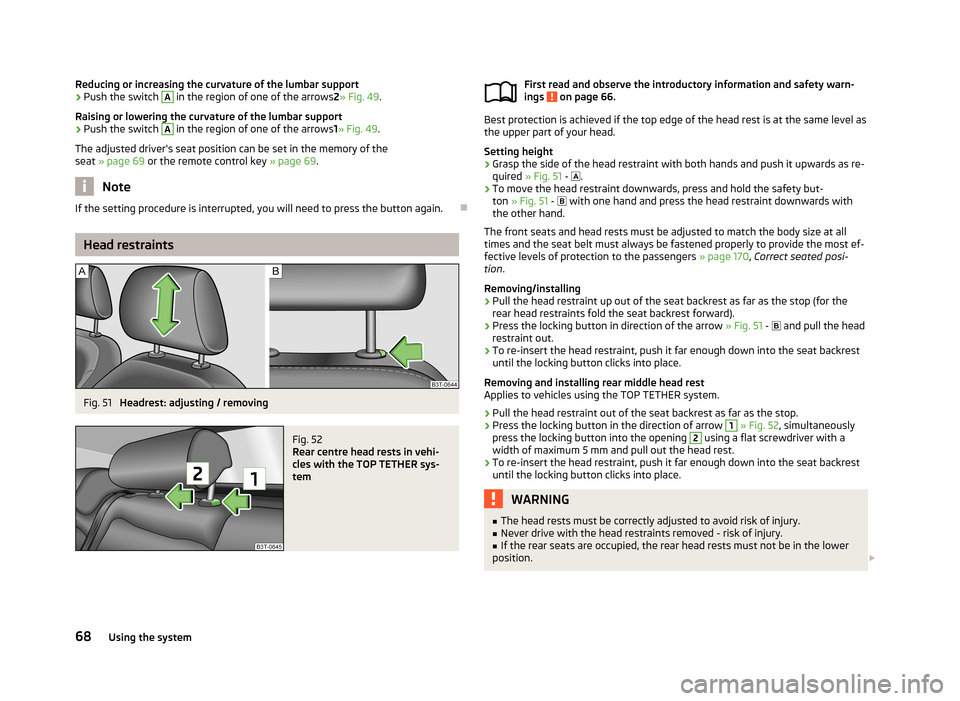
Reducing or increasing the curvature of the lumbar support›Push the switch A in the region of one of the arrows2» Fig. 49 .
Raising or lowering the curvature of the lumbar support›
Push the switch
A
in the region of one of the arrows 1» Fig. 49 .
The adjusted driver's seat position can be set in the memory of the
seat » page 69 or the remote control key » page 69.
Note
If the setting procedure is interrupted, you will need to press the button again.
Head restraints
Fig. 51
Headrest: adjusting / removing
Fig. 52
Rear centre head rests in vehi-
cles with the TOP TETHER sys-
tem
First read and observe the introductory information and safety warn-
ings on page 66.
Best protection is achieved if the top edge of the head rest is at the same level as the upper part of your head.
Setting height
›
Grasp the side of the head restraint with both hands and push it upwards as re-
quired » Fig. 51 - .
›
To move the head restraint downwards, press and hold the safety but-
ton » Fig. 51 - with one hand and press the head restraint downwards with
the other hand.
The front seats and head rests must be adjusted to match the body size at all
times and the seat belt must always be fastened properly to provide the most ef-
fective levels of protection to the passengers » page 170, Correct seated posi-
tion .
Removing/installing
›
Pull the head restraint up out of the seat backrest as far as the stop (for the rear head restraints fold the seat backrest forward).
›
Press the locking button in direction of the arrow » Fig. 51 -
and pull the head
restraint out.
›
To re-insert the head restraint, push it far enough down into the seat backrest until the locking button clicks into place.
Removing and installing rear middle head rest Applies to vehicles using the TOP TETHER system.
›
Pull the head restraint out of the seat backrest as far as the stop.
›
Press the locking button in the direction of arrow
1
» Fig. 52 , simultaneously
press the locking button into the opening
2
using a flat screwdriver with a
width of maximum 5 mm and pull out the head rest.
›
To re-insert the head restraint, push it far enough down into the seat backrest until the locking button clicks into place.
WARNING■ The head rests must be correctly adjusted to avoid risk of injury.■Never drive with the head restraints removed - risk of injury.■
If the rear seats are occupied, the rear head rests must not be in the lower
position. 68Using the system
Page 74 of 274
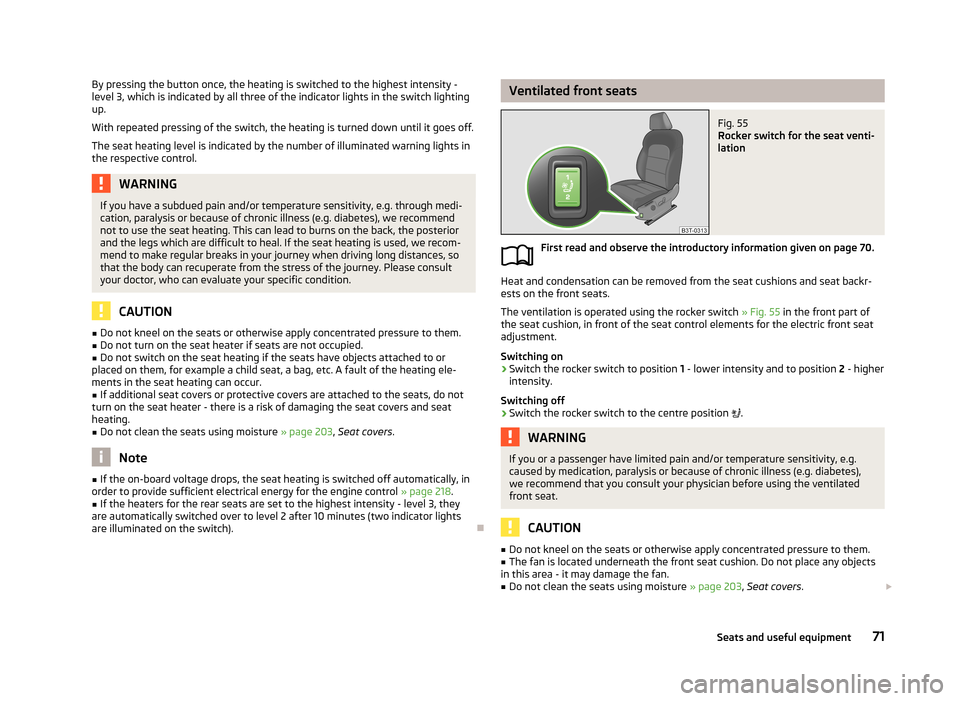
By pressing the button once, the heating is switched to the highest intensity -level 3, which is indicated by all three of the indicator lights in the switch lightingup.
With repeated pressing of the switch, the heating is turned down until it goes off. The seat heating level is indicated by the number of illuminated warning lights inthe respective control.WARNINGIf you have a subdued pain and/or temperature sensitivity, e.g. through medi-
cation, paralysis or because of chronic illness (e.g. diabetes), we recommend
not to use the seat heating. This can lead to burns on the back, the posterior
and the legs which are difficult to heal. If the seat heating is used, we recom-
mend to make regular breaks in your journey when driving long distances, so
that the body can recuperate from the stress of the journey. Please consult
your doctor, who can evaluate your specific condition.
CAUTION
■ Do not kneel on the seats or otherwise apply concentrated pressure to them.■Do not turn on the seat heater if seats are not occupied.■
Do not switch on the seat heating if the seats have objects attached to or
placed on them, for example a child seat, a bag, etc. A fault of the heating ele-
ments in the seat heating can occur.
■
If additional seat covers or protective covers are attached to the seats, do not
turn on the seat heater - there is a risk of damaging the seat covers and seat
heating.
■
Do not clean the seats using moisture » page 203, Seat covers .
Note
■
If the on-board voltage drops, the seat heating is switched off automatically, in
order to provide sufficient electrical energy for the engine control » page 218.■
If the heaters for the rear seats are set to the highest intensity - level 3, they
are automatically switched over to level 2 after 10 minutes (two indicator lights
are illuminated on the switch).
Ventilated front seatsFig. 55
Rocker switch for the seat venti-
lation
First read and observe the introductory information given on page 70.
Heat and condensation can be removed from the seat cushions and seat backr- ests on the front seats.
The ventilation is operated using the rocker switch » Fig. 55 in the front part of
the seat cushion, in front of the seat control elements for the electric front seat
adjustment.
Switching on
›
Switch the rocker switch to position 1 - lower intensity and to position 2 - higher
intensity.
Switching off
›
Switch the rocker switch to the centre position
.
WARNINGIf you or a passenger have limited pain and/or temperature sensitivity, e.g.
caused by medication, paralysis or because of chronic illness (e.g. diabetes),
we recommend that you consult your physician before using the ventilated
front seat.
CAUTION
■ Do not kneel on the seats or otherwise apply concentrated pressure to them.■The fan is located underneath the front seat cushion. Do not place any objects
in this area - it may damage the fan.■
Do not clean the seats using moisture » page 203, Seat covers .
71Seats and useful equipment
Page 76 of 274
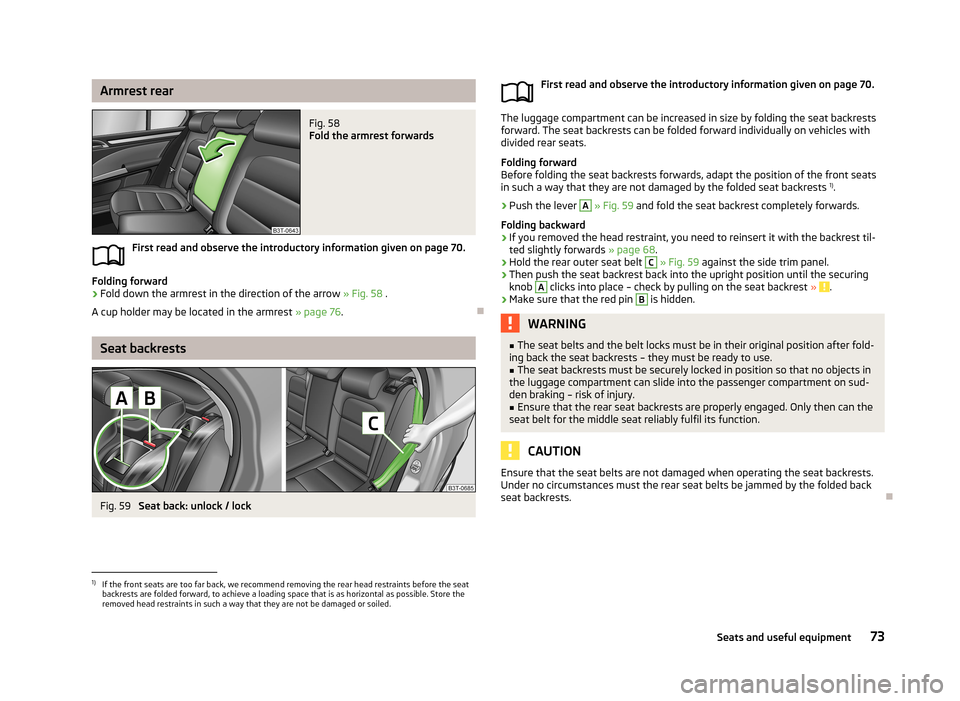
Armrest rearFig. 58
Fold the armrest forwards
First read and observe the introductory information given on page 70.
Folding forward
›
Fold down the armrest in the direction of the arrow » Fig. 58 .
A cup holder may be located in the armrest » page 76.
Seat backrests
Fig. 59
Seat back: unlock / lock
First read and observe the introductory information given on page 70.
The luggage compartment can be increased in size by folding the seat backrests
forward. The seat backrests can be folded forward individually on vehicles with
divided rear seats.
Folding forward
Before folding the seat backrests forwards, adapt the position of the front seats
in such a way that they are not damaged by the folded seat backrests 1)
.
›
Push the lever
A
» Fig. 59 and fold the seat backrest completely forwards.
Folding backward
›
If you removed the head restraint, you need to reinsert it with the backrest til- ted slightly forwards » page 68.
›
Hold the rear outer seat belt
C
» Fig. 59 against the side trim panel.
›
Then push the seat backrest back into the upright position until the securing
knob
A
clicks into place – check by pulling on the seat backrest » .
›
Make sure that the red pin
B
is hidden.
WARNING■
The seat belts and the belt locks must be in their original position after fold-
ing back the seat backrests – they must be ready to use.■
The seat backrests must be securely locked in position so that no objects in
the luggage compartment can slide into the passenger compartment on sud-
den braking – risk of injury.
■
Ensure that the rear seat backrests are properly engaged. Only then can the
seat belt for the middle seat reliably fulfil its function.
CAUTION
Ensure that the seat belts are not damaged when operating the seat backrests. Under no circumstances must the rear seat belts be jammed by the folded back
seat backrests.
1)
If the front seats are too far back, we recommend removing the rear head restraints before the seat
backrests are folded forward, to achieve a loading space that is as horizontal as possible. Store the
removed head restraints in such a way that they are not be damaged or soiled.
73Seats and useful equipment
Page 77 of 274
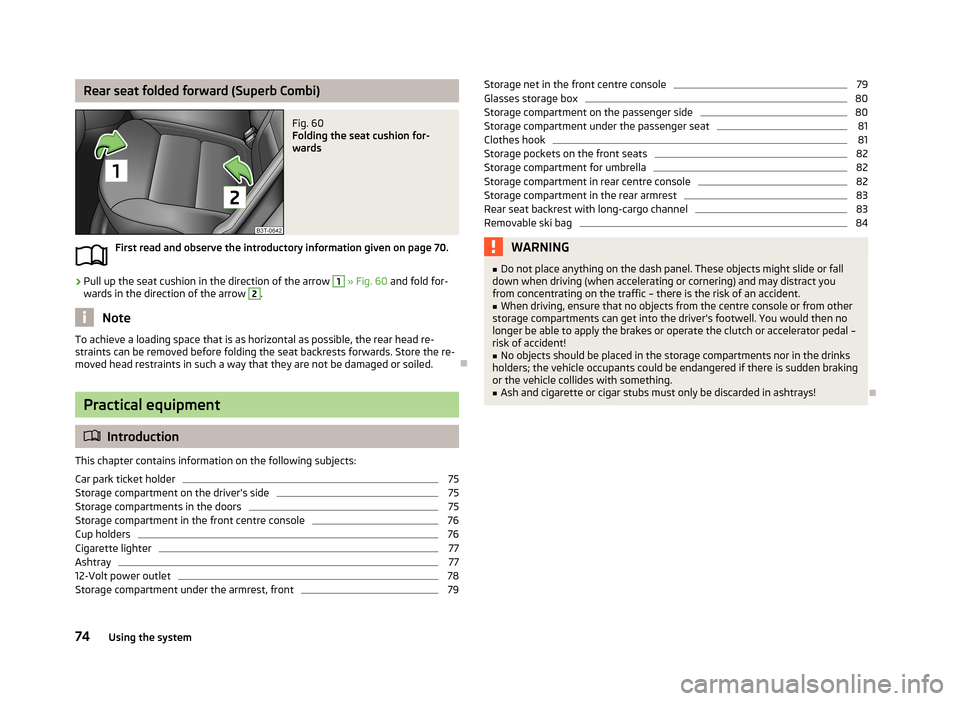
Rear seat folded forward (Superb Combi)Fig. 60
Folding the seat cushion for-
wards
First read and observe the introductory information given on page 70.
›
Pull up the seat cushion in the direction of the arrow
1
» Fig. 60 and fold for-
wards in the direction of the arrow
2
.
Note
To achieve a loading space that is as horizontal as possible, the rear head re-
straints can be removed before folding the seat backrests forwards. Store the re- moved head restraints in such a way that they are not be damaged or soiled.
Practical equipment
Introduction
This chapter contains information on the following subjects:
Car park ticket holder
75
Storage compartment on the driver's side
75
Storage compartments in the doors
75
Storage compartment in the front centre console
76
Cup holders
76
Cigarette lighter
77
Ashtray
77
12-Volt power outlet
78
Storage compartment under the armrest, front
79Storage net in the front centre console79Glasses storage box80
Storage compartment on the passenger side
80
Storage compartment under the passenger seat
81
Clothes hook
81
Storage pockets on the front seats
82
Storage compartment for umbrella
82
Storage compartment in rear centre console
82
Storage compartment in the rear armrest
83
Rear seat backrest with long-cargo channel
83
Removable ski bag
84WARNING■ Do not place anything on the dash panel. These objects might slide or fall
down when driving (when accelerating or cornering) and may distract you
from concentrating on the traffic – there is the risk of an accident.■
When driving, ensure that no objects from the centre console or from other
storage compartments can get into the driver's footwell. You would then no
longer be able to apply the brakes or operate the clutch or accelerator pedal –
risk of accident!
■
No objects should be placed in the storage compartments nor in the drinks
holders; the vehicle occupants could be endangered if there is sudden braking
or the vehicle collides with something.
■
Ash and cigarette or cigar stubs must only be discarded in ashtrays!
74Using the system
Page 78 of 274

Car park ticket holderFig. 61
Windscreen: Parking ticket hold-
er
First read and observe the introductory information and safety warn-
ings on page 74.
The note holder is designed e.g. for attaching car park tickets.
WARNINGThe attached note has to always be removed before starting off in order not
to restrict the driver's vision.
Storage compartment on the driver's side
Fig. 62
Storage compartment on the
driver's side
First read and observe the introductory information and safety warn- ings on page 74.
Opening
›
Raise the handle
A
» Fig. 62 and open out the compartment in the direction of
the arrow.
Closing›Swivel the lid against the direction of the arrow until it clicks into place.WARNINGThe storage compartment must always be closed when driving for safety rea-
sons.
Storage compartments in the doors
Fig. 63
Storage compartment: in the front door/in the rear door
First read and observe the introductory information and safety warn-
ings
on page 74.
WARNINGUse the storage compartment only for storing objects which do not project so
that the effectiveness of the side airbag is not impaired.
75Seats and useful equipment
Page 80 of 274

WARNING■Never put hot beverage containers in the cup holder. If the vehicle moves,
they may spill – risk of scalding!■
Do not use any cups or beakers which are made of brittle material (e.g. glass,
porcelain). This could lead to injuries in the event of an accident.
CAUTION
■ Do not leave open beverage containers in the cup holder during the journey.
There is a risk of spilling e.g. when braking which may cause damage to the elec- trical components or seat upholstery.■
Slide in the cup holder before raising the rear armrest.
Cigarette lighter
Fig. 67
Centre console: Cigarette lighter, front/rear
First read and observe the introductory information and safety warn- ings
on page 74.
Usage
›
Press the button of the cigarette lighter
A
or
B
» Fig. 67 .
›
Wait until the button pops forward.
›
Remove the cigarette lighter immediately and use.
›
Place the cigarette lighter back into the socket.
WARNING■
Take care when using the cigarette lighter! Improper usage can case burns.■The cigarette lighter also operates when the ignition is switched off or the
ignition key withdrawn. Therefore never leave children unattended in the ve-
hicle.
Note
■ The cigarette lighter socket can also be used as a 12Volt socket for electrical ap-
pliances » page 78 , 12-Volt power outlet .■
Further information » page 193, Services, modifications, and technical altera-
tions .
Ashtray
Fig. 68
Centre console: Ashtray at the front/rear
First read and observe the introductory information and safety warn- ings
on page 74.
The ashtray can be used for discarding ash, cigarettes, cigars and the like » .
Removing/inserting the front ash tray
›
Open the ashtray » Fig. 64 on page 76.
›
Grasp the ashtray insert in the area
A
» Fig. 68 and remove it in the direction of
the arrow
1
.
Insertion takes place in the reverse order.
Removing/inserting the rear ashtray insert
›
Open the ashtray » Fig. 77 on page 82.
77Seats and useful equipment
Page 94 of 274

The lamp is supplied by three rechargeable type AAA batteries. The rechargeable
batteries are constantly charged when the engine is running. It takes approx. 3
hours to fully charge the rechargeable batteries.
The lamp is fitted with magnets. Therefore it is possible to attach the lamp, forexample on the vehicle body, after removing it.
CAUTION
The removable lamp is not watertight and must therefore be protected against
moisture.
Note
■ If the lamp is not correctly inserted into the holder, it does not light up when
the boot lid is opened and the rechargeable batteries are not charged.■
If the lamp is not switched off and it is correctly inserted in the holder, the bulbs
in the front part
C
» Fig. 92 on page 91 of the lamp are automatically switched
off.
Use light
Fig. 92
Use light / remove light
First read and observe the introductory information and safety warn-
ings
on page 90.
Use light
›
If you press button
A
» Fig. 92 once, the lamp lights up with 100 % light inten-
sity.
›
If you press button
A
again, the lamp lights up with 50 % light intensity.
›
Press
A
button once again - the light goes out.
Remove the lamp from the holder›Grasp the lamp in the areas of the arrows D » Fig. 92 and swivel it in the direc-
tion of the arrow E
.
Reinserting the lamp the holder
›
First of all place the deactivated lamp in the holder on the side facing the boot lid and then press on the lamp from the other side until it is clicks into place.
Changing rechargeable light batteries
First read and observe the introductory information and safety warn-ings
on page 90.
Proceed as follows if you wish to replace the faulty rechargeable batteries your-
self:
›
Remove the lamp.
›
Lever off the cover for the rechargeable batteries with a narrow and pointed object from the location of the lock-off clips
F
» Fig. 92 on page 91.
›
Remove the faulty rechargeable batteries from the lamp.
›
Insert the new rechargeable batteries.
›
Insert the cover for the rechargeable batteries and press it down until it clicks
into place.
CAUTION
We recommend having faulty rechargeable batteries replaced by a ŠKODA service
partner. If the lamp is not correctly opened, it can be damaged.
For the sake of the environment
Dispose of used rechargeable batteries in accordance with national legal provi-
sions.
Note
■ Pay attention to the correct polarity when changing the rechargeable batteries.■The replacement rechargeable batteries must have the same specification as
the original rechargeable batteries. If other types of rechargeable batteries are
used, the power output can be reduced or it can lead to a malfunction of the
lamp.
91Seats and useful equipment